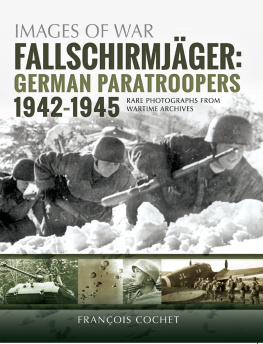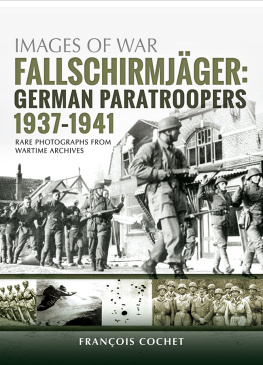JUMP INTO HELL
English translation 2010 by Battle Born Books and Consulting
Published in 2010 by
STACKPOLE BOOKS
5067 Ritter Road
Mechanicsburg, PA 17055
www.stackpolebooks.com
All rights reserved, including the right to reproduce this book or portions thereof in any form or by any means, electronic or mechanical, including photocopying, recording, or by any information storage and retrieval system, without permission in writing from the publisher.
Printed in the United States of America
10 9 8 7 6 5 4 3 2 1
Library of Congress Cataloging-in-Publication Data
Kurowski, Franz.
[Deutsche Fallschirm-Jger, 19391945 English.]
Jump into hell : German paratroopers in World War II / Franz Kurowski.
p. cm.
Includes bibliographical references and index.
ISBN 978-0-8117-0582-0
1. Germany. HeerParachute troopsHistory20th century. 2. World War, 19391945Aerial operations, German. I. Title.
D757.63.K87513 2010
940.54'1343dc22
2009028377
CHAPTER 1
From Paratroopers to Airborne Forces, the Buildup
W hen the former commander of the American Air Corps in France during the First World War, Major General William Billy Mitchell, published his memoirs in 1930, attentive readers were captivated by one of his chapters. They read about the planning for an offensive from the air against Ypres. Major General Mitchell had proposed the parachuting of the U.S. 1st Infantry Division when the Allies failed to break through the German front at Menin-Roselare.
It was intended to parachute the infantry behind the front. This first airborne force was to be supplied with ammunition, machine-guns and rations from the air by means of giant cargo chutes. All of the aircraft of the Alliessome 2,000 machineswere to support the offensive from the air by bombing and strafing the German front.
Major General Mitchell was firmly convinced that such an attack, which had never before been attempted, would force the breakthrough at Roselare and cause the German front to collapse. But the operation was postponed to February 1919. Thus, the end of the war thwarted the first operation from the third dimension.
Many declared the generaleven twelve years after the war had endedas crazy. That wasnt the case in the Soviet Union, however. There, the first airborne formations were activated as early as 1928. The Commander-in-Chief of the Red Army at the time, Marshall Tuchatschewskij, was a strong proponent of the new concept. In the process, he was also strongly supported by the Minister of Defense, Woroschilow.
During the maneuvers of 1931, the Soviets attempted the first jump of a group of paratroopers in the area around Woronesch. The group consisted of a lieutenant and six men. They jumped with a heavy machine-gun from an Antonov 14, which had transported them to their jump zone. The group pressed forward to a corps command post and took it prisoner.
At the time, the interwar German military, the Reichswehr, was also acquainted with the idea of using paratroopers as an attack force, but it never went beyond the theoretical stage.
The Soviet maneuvers were followed a year later by the first actual operation, when the Soviet military needed to overpower a group of bandits from Basmach, who had heretofore been able to escape capture by the military. A platoon of paratroopers jumped in with a few machine-guns and blocked the area behind the bandits. Once the escape route had been sealed, the ground forces were able to advance and eliminate them.
The Ossawiachima club for those interested in aviation and related mattersestablished parachuting clubs in all of the larger cities of the Soviet Union. All different parachute types throughout the world were brought in and tested. The best of the designs were then copiedwithout permission, of course.
In the winter of 1931, Marshall Tuchatschewskij ordered that all aviators were to be trained to parachute. The idea of air-transporting forces for landing them in the rear of the enemy seemed to have caught hold in the Soviet Union. That thought was conveyed in France in 1932 when the Soviet air general Schtscherbakow visited. He was guided through the Maginot Line, where Marshall Ptain, full of pride, told him that it was impregnable.
The Soviet general replied: These facilities and fortresses will be completely superfluous in the future. When an enemy takes to heart the recommendations of General Mitchell, he can simply jump past them. Parachute divisions will land to the rear of these gigantic fortifications and cut them off from their lines of communication.
Marshall Ptain was taken aback momentarily, but he then regained his composure and smiled: That, my dear general, most assuredly will never happen.
Despite that assurance, the aged French Marshall soon issued a directive that air defenses were to be constructed in the vicinity of the Maginot Line and heavy antiaircraft batteries to be positioned near all fortress facilities.
The training for airborne warfare continued in Moscow. In the Aero-Hydrodynamic Central Institute, aircraft and power plants purchased abroad were taken apart and reverse engineered. By 1932, some 1,500 airframes had been constructed. By 1937, the Soviet Commander-in-Chief wanted to have 8,000 aircraft on hand. In order to man those aircraft, the military branch of the Ossawiachim had all of its membersboth male and femaletrained as pilots, observers, radio operators and parachutists. The Air Academy and the Training Institute for Navigationin all, a total of 20 aviation preparatory schools and 32 schools for mechanics, maintenance personnel and meteor-ologistsprovided the ground personnel. In the large amusement park in Moscow, a parachute tower, from which young people could jump with parachutes, was constructed in 1932.
During the Moscow Aviation Days of 1933 and again in 1934, some 400 parachutists jumped from around 5,000 meters, free fell some 4,000 meters and then opened their chutes simultaneously at 1,000 meters.
It was not until 1935, however, that there was a massed jump by a larger parachute formation. This was done during the summer maneuvers in the Ukraine. No fewer than 1,000 parachutists jumped at the same time. They then secured an airfield for the air landing of 5,000 additional forces.
The Soviet demonstration had deeply impressed the military forces of the world. Colonel Archibald P. Wavell, the future senior commander in the Near East and Africa, wrote the following to his government: If I had not personally witnessed this operation, I would have never believed that such a thing were possible.
The German military attach in Moscow also reported the massed jump of parachutists to Berlin. Although the formation of an airborne force had already been contemplated in Germany, the attachs report gave urgency to the matter. It was something like the spark that set off the fire for the development of German airborne forces.
It was intended in 1936 for 1,500 parachutists of the Red Army to force a river crossing during an exercise and then open up an avenue of advance for an attacking corps. That maneuver also succeeded and it appeared as though the Soviet Union would be the first country in the world to have a fully formed and trained airborne force. But with the fall of the Commander-in-Chief of the Red Army (Marshall Tuchatschewskij fell victim to a purge on the part of Stalin), the thought also disappeareda thought that had almost been transformed into practiceof having an operational airborne force. Even during the Second World War there were few Soviet airborne operations and those were largely unsuccessful.










